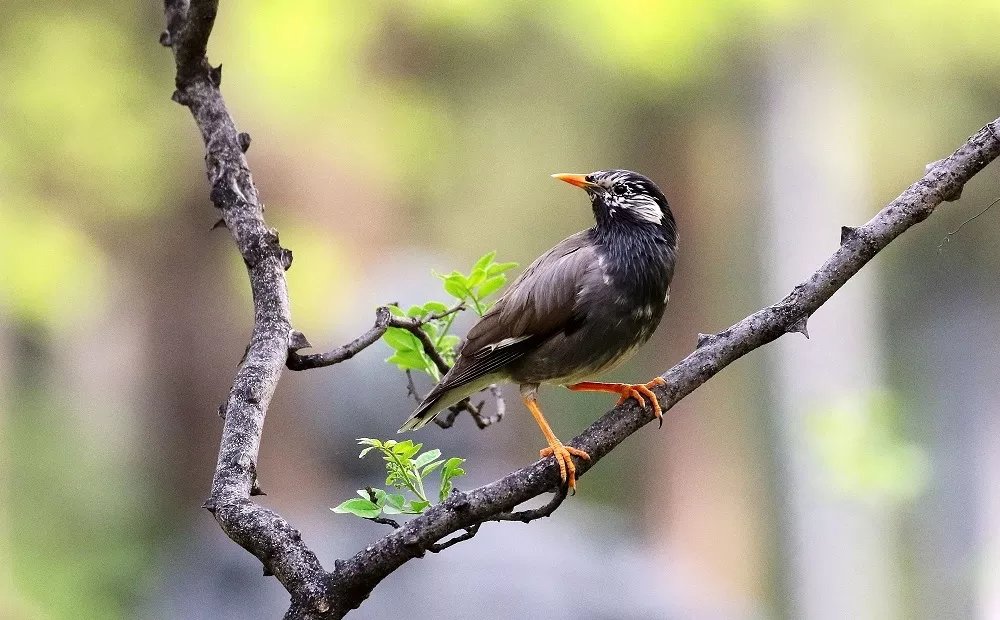The White-cheeked Starling (Spodiopsar cineraceus), also known as the Grey Starling, is a captivating bird species native to Southeast Asia. With its distinctive appearance, enchanting vocalizations, and engaging behaviors, this starling has become a favorite among bird enthusiasts and nature lovers. In this article, we will explore the key characteristics, habitat, behavior, and conservation status of the White-cheeked Starling, shedding light on its significance in the avian world.
Physical Appearance:
The White-cheeked Starling exhibits unique features that make it easily identifiable:
Plumage: Adults have an overall slate-gray coloration on their head, back, and wings, with a paler grayish-white underbelly. The most striking feature is the white patch on their cheeks, which contrasts with the dark coloration of their eyes and beak.
Size: This medium-sized starling measures approximately 21-23 centimeters (8-9 inches) in length, with males and females exhibiting similar sizes and plumage.
Distribution and Habitat:
The White-cheeked Starling is native to a range of Southeast Asian countries, including Thailand, Myanmar, Laos, Vietnam, Cambodia, and parts of China. Within these regions, it inhabits a variety of habitats such as open woodlands, deciduous forests, riverine areas, grasslands, agricultural fields, and urban parks.
Behavior and Vocalizations:
Flocking Behavior: White-cheeked Starlings are highly sociable birds, often found in small to large flocks, especially during the non-breeding season. These flocks can consist of hundreds or even thousands of individuals, providing a spectacle of synchronized flight and vocalizations.
Vocalizations: This starling species is known for its diverse range of vocalizations. They produce a mix of melodious songs, chattering calls, whistles, and mimicry of other bird species. Their vocalizations serve as a means of communication within the flock and during courtship displays.
Breeding:
Breeding Behavior: During the breeding season, which typically occurs from February to July, White-cheeked Starlings form monogamous pairs. They construct cup-shaped nests made of twigs, grass, and leaves, often placed in tree cavities or man-made structures. Females lay a clutch of 3-5 eggs, which are incubated by both parents for around 12-14 days.
Threats:
The White-cheeked Starling is categorized as a species of “Least Concern” on the IUCN Red List. However, the White-cheeked starling faces several threats that could potentially harm their populations. Habitat loss due to deforestation and urbanization is a significant concern for this species. Additionally, they may face predation from birds of prey like the Eurasian Sparrowhawk or domestic cats. Human activity, such as hunting and trapping for the pet trade, has also impacted their populations.
Conservation Efforts:
Due to these threats, conservation efforts for the White-cheeked starling have been implemented throughout East Asia. In China, it is listed as a Class II protected wild animal, which prohibits hunting and trading. Taiwan has also established several nature reserves to protect their remaining populations. Additionally, research efforts have been made to better understand their behavior and ecology, which can inform future conservation strategies.
Ecological Significance:
Seed Dispersal: White-cheeked Starlings play a vital role in seed dispersal. As they consume fruits and berries, they aid in the propagation and distribution of plant species, contributing to the diversity of ecosystems they inhabit.
Pest Control: By foraging on insects and small invertebrates, these starlings assist in regulating pest populations, providing a natural form of insect control within their habitats.
Conclusion:
The White-cheeked Starling, with its elegant plumage, captivating vocalizations, and engaging social behavior, is a true gem of Southeast Asia. Its presence adds vibrancy and charm to a range of habitats, from woodlands to urban parks. By understanding the characteristics, behaviors, and conservation needs of the White-cheeked Starling, we can appreciate the importance of preserving the rich avian biodiversity of our planet and ensure the survival of this charismatic species for generations to come.


 Facebook
Facebook  Instagram
Instagram  Youtube
Youtube 